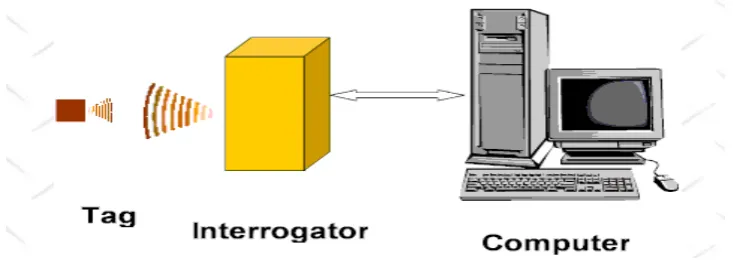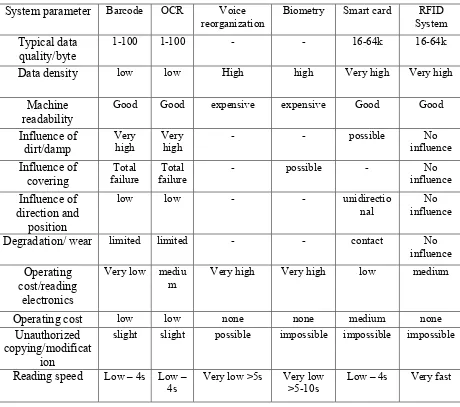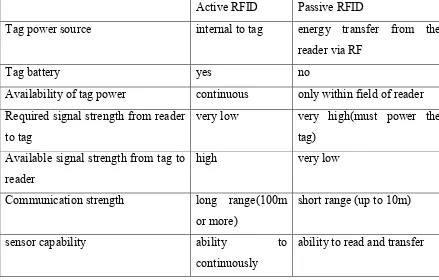RFID BASED AIRPORT LUGGAGE SECURITY SYSTEM
ZAINIE BINTI ZAINUDIN
This Report Is Submitted In Partial Fulfilment Of Requirements For The Bachelor Degree of Electronic Engineering (Telecommunication Electronics)
Faculty of Electronic Engineering & Computer Engineering Universiti Teknikal Malaysia Melaka
ii
Tajuk Projek : RFID BASED AIRPORT LUGGAGE SECURITY SYSTEM
Sesi
Pengajian : 1 3 / 1 4
Saya ZAINIE BINTI ZAINUDIN mengaku membenarkan Laporan Projek Sarjana Muda ini disimpan di Perpustakaan dengan syarat-syarat kegunaan seperti berikut:
1. Laporan adalah hakmilik Universiti Teknikal Malaysia Melaka.
2. Perpustakaan dibenarkan membuat salinan untuk tujuan pengajian sahaja.
3. Perpustakaan dibenarkan membuat salinan laporan ini sebagai bahan pertukaran antara institusi pengajian tinggi.
4. Sila tandakan ( √ ) :
SULIT*
*(Mengandungi maklumat yang berdarjah keselamatan atau kepentingan Malaysia seperti yang termaktub di dalam AKTA RAHSIA RASMI 1972)
TERHAD** **(Mengandungi maklumat terhad yang telah ditentukan oleh organisasi/badan di mana penyelidikan dijalankan)
TIDAK TERHAD
Disahkan oleh:
__________________________ ___________________________________
(TANDATANGAN PENULIS) (COP DAN TANDATANGAN PENYELIA)
iii
"I recognize this report is the result of my own work except for a summary and quote of each of them I have mentioned the source"
Signature :………
Author Name : ZAINIE BINTI ZAINUDIN
iv
“I / we declare that I have read this on my mind / we are of sufficient scope and quality of the award of Bachelor of Electronic Engineering (Telecommunications)”
Signature :………
Supervisor Name : MR HARRIS BIN MISRAN
v
DEDICATION
I dedicate this report to my beloved parents, supportive supervisor, classmate and people who have guide me. Without their support and understanding the completion
vi
ACKNOWLEDGEMENT
vii
ABSTRACT
viii
ABSTRAK
xi IV RESULT AND DISCUSSION
4.1 Achievement and Result 32
4.2 Database system 33
4.3Software system 36
4.3.1 Authorized passenger tags identification process 39 4.3.2 Unauthorized passenger tags identification process 40
4.3.3 Update date in 45
4.3.4 Update date out 46
4.4 Discussion 47
V CONCLUSIONS AND RECOMMENDATIONS
5.1 Conclusion 48
5.2 Recommendations 49
xii
LIST OF TABLES
NO TITLE PAGE
2.1 Comparison between RFID systems with others technology 6 Systems
2.2 Comparison between active RFID and passive RFID 8
xiii
LIST OF FIGURES
NO TITLE PAGE
2.1 Diagram of RFID system 5
2.2 Clamshell RFID tag 8
3.1 Project flow chart 17
3.2 Check in process flow chart 18
3.3 Check out process flow chart 19
3.4 Gantt chart PSM 20
3.5 Identify database element 22
3.6 Current time and date 25
3.7 Visual Basic 2010 Express Edition 26
3.8 Windows Form Application 27
3.9 Add Windows Form 27
3.10 Add new item into Windows Application 27
3.11 Change the text on a label 28
3.12 Invalid username or password 29
xiv
3.14 Button and textbox 30
3.15 Text in properties 31
4.1 Block diagram for a complete RFID system 32
4,2 Airport luggage security system database 33
4.3 Airport luggage security system form to key in the 34
Passenger details
4.4 Airport luggage security system report 35
4.5 Home page Airport luggage security system 36
4.6 Login page for Airport luggage security system 36
4.7 Home page of software system 37
4.14 Successful registered passenger detail 42
4.15 Registered passenger stored in the database 43
4.16 Profile info form 44
4.17 The details stored in profile info form 44
xv
4.19 Update date in 45
xvi
LIST OF APPENDICES
NO TITLE PAGE
A Datasheet RFID reader 52
1
CHAPTER I
INTRODUCTION
“Airport Luggage Security System using Radio-frequency identification (RFID)” is designed and develops to assists the needs of today where a lot of luggage has been lost at the airport. It is a very useful device and able to be used at the airport as a security concern in order to maintain their quality and performance. This chapter will summarily discuss the project background, objectives, scope and the problem statement and last but not least project methodology.
1.1 Project Background
2 left with intention such as crime purpose. This project will use an RFID as airport luggage security system to trace an authorized person with their luggage. RFID tags will be provided to all passengers and their detail will be key in to the system. RFID reader will read the unique RFID number from the RFID tags.
1.2 Problem Statement
Nowadays, airports are overcrowded, passenger might be issues with the luggage lost and the lost including mishandling, stolen, airport system, left and left with intention such as crime purpose. The cost generate by luggage loss are very high for both the airlines and the airports.
In this project, Radio Frequency Identification (RFID) technology has been implement and it has become well-known technology for many type of security or item’s identification system. By using RFID, it will help the system to work faster, convenient and effective for other user that using this system.
1.3 Project Objectives
3 1.4 Scope Project
This project involves with study the RFID based airport luggage security system. RFID is a fast and reliable means of identifying just about any material object. Primarily, the two main components involved in RFID system are the RFID tags and RFID reader. RFID tags that used in this project is passive type with frequency of 13.56Mhz.The maximum read distance about 1.5meters but with a constraints of budget, RFID 125 kHz tag and reader are used and it is affordable for this project. This project will focus on RFID interface and RFID hardware. RFID interface will be programmed by using visual basic programming to trace the passenger and luggage is authorized or unauthorized. This system will use Microsoft access as a database to insert all the details of passenger and their luggage. RFID will interact with the database and come out with the output either the passenger and luggage is authorized or unauthorized.
1.5 Project Methodology
4
CHAPTER II
LITERATURE REVIEW
Literature review about this project is done by gathering information from internet, journal, article, and books in order to get knowledge. Literature review is necessary before started the project and the researches regarding the project are significant in understanding the concept of the overall project. This chapter discusses about Radio Frequency Identification (RFID).
2.1 History of RFID
RFID tags have been around a lot longer than most people think. In 1946, a man named Leon Theremin created a device for the Soviet Union that retransmitted radio waves with audio information. This was created for espionage purposes. This might not be used for identification but it is credited as being the predecessor to RFID.
5 The demonstration of the device was performed at the Los Alamos Scientific Laboratory in 1973 by Steven Depp, Alfred Koelle, and Robert Freyman. This device used 12 bit tags. The first patent that is associated with our modern day RFID technology belongs to Charles Walton. He received in 1983.
2.2 Introduction to RFID
RFID (Radio Frequency Identification) is a technology which is used to identify or detect an object. The communication is between a reader (interrogator) and a transponder (tag). There are two types of tags which is active tag or passive tag. Diagram of RFID system is shows in Figure 2.1. When the tag enters the reader reading field, the tag will be activated by the electromagnetic wave from the reader. The passive tag converts the electromagnetic field to power up its internal circuits. Then the circuit in the tag will modulate the waves and transmit back the stored information. After that, the reader will decode the data and send it to CPU for processing. [2]
Figure 2.1 Diagram of RFID system
RFID system is consist of two components:
• The transponder, which is located on the object to be identified.
6 A reader typically contains a radio frequency module (transmitter and receiver), a control unit and a coupling element to the transponder. In addition, many readers are fitted with an additional interface (RS 232, RS 485, etc) to enable them to forward the data received to another system (PC, robot control system, etc).
RFID system has effective characteristic in identification system compared to others technology. Table shows the advantages of RFID system by comparing some system parameters.
Table 2.1: Comparison between RFID systems with others technology systems
System parameter Barcode OCR Voice
reorganization Biometry Smart card System RFID
Typical data
quality/byte 1-100 1-100 - - 16-64k 16-64k
Data density low low High high Very high Very high
Machine
readability Good Good expensive expensive Good Good Influence of
slight slight possible impossible impossible impossible
Reading speed Low – 4s Low –
7 2.4 Type of RFID Tag and Its Frequencies
This part will discussed about specification of RFID tags.
2.3.1 Type of RFID Tag
The tags communicate to a RFID reader via radio frequency. There are many types of RFID tags. These types are :
• Passive tags • Semi passive tags • Active tags
Below are details of each type of RFID tags.
2.3.2 Passive
No internal source of power is needed. The minute the electrical current induced in the antenna by the incoming radio frequency signal provides just enough power for the CMOS integrated circuit in the tag to power up and transmits a
8 2.3.4 Active
Active tag has their own internal power source which is used to power any ICs that generate the outgoing signal. They are more reliable (fewer errors) due to the ability for active tag to conduct a session with a reader. Because of their onboard power supply also transmit at higher power level than passive tags, allowing them to be more effective in “RF challenged” environments such as water, metal or at longer distances.[11] A battery can live up to 10 years and have practical ranges of hundred of meters. Types of tags that were used in the RFID system are ISO card, clamshell card and also soft label.[11] Figure 2.2 shows the example of clamshell card. The typical reading distance for this card is 15cm to 90 cm but still depending on the reader, the one sending electromagnetic wave to energize the RFID tag.
Figure 2.2 Clamshell RFID tag
Table 2.2: Comparison between active RFID and passive RFID
Active RFID Passive RFID
Tag power source internal to tag energy transfer from the reader via RF
Tag battery yes no


